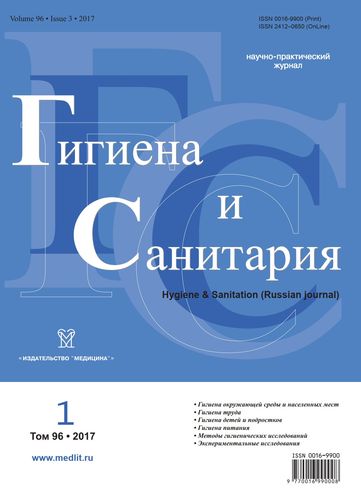Modern analytical techniques in the determination of highly n-nitrosamines in biological fluids (blood)
- 作者: Nurislamova T.V.1,2, Ulanova T.S.1,2, Popova N.A.1, Maltseva O.A.1
-
隶属关系:
- Federal Scientific Center for Medical and Preventive Health Risk Management Technologies
- Perm National Research Polytechnic University
- 期: 卷 96, 编号 1 (2017)
- 页面: 84-89
- 栏目: METHODS OF HYGIENIC AND EXPERIMENTAL INVESTIGATIONS
- ##submission.datePublished##: 21.10.2020
- URL: https://freezetech.ru/0016-9900/article/view/640600
- DOI: https://doi.org/10.47470/0016-9900-2017-96-1-84-89
- ID: 640600
如何引用文章
全文:
详细
There are given results of experimental research on the development of the high-sensitive and selective chromato-mass-spectrometric methodfor the detection of the N-nitrosamines (N-nitrosodimethylamine andN-nitrosodiethylamine) in blood with the use of distillation and automated system of solid-phase extraction Sepaths (Italy) on the cartridges Coconut 6 cm3 at the stage of sample preparation. Chromato-mass-spectrometric analysis of the extract allowed the detection of the completeness of extraction of N-nitrosodimethylamine from blood equal to 98.5% and for N-nitrosodiethylamine - to 100%.The developed chromato-mass-spectrometric method for the detection of N-nitrosamines in biological media (blood) allows the execution of the control of contents of N-nitrosodimethylamine and N-nitrosodiethylamine in the concentration range of 0.002 - 0.1 mg/dm3 at error not more than 27%. The usage of the developed method for the detection of blood N-nitrosamines levels in groups of the observed child population consuming drink water with different content of nitrates allowed to determine a verified difference and excess of N-nitrosamines content by 2.8 times in the group with higher nitrates content in the drinking water as compared to the group of observed cases who drink water with standard content of nitrates. In order to confirm the presence of the defined N-nitrosamines in the blood samples of the people under research there was executed chromato-mass-spectrometric identification in the SCAN mode. Mass spectrums of N-nitrosodimethylamine and N-nitrosodiethylamine discovered in blood samples of observed cases were compared to mass spectrums of NIST 08.L library. The results of identification of N-nitrosodimethylamine and N-nitrosodiethylamine in the blood samples showed that determined compounds have the same structure as the ones given in the library. The method can be used for biomonitoring, sanitary-epidemiological examinations, and researches in evidentiary medicine in order to determine the impact of the unfavourable anthropogenic factors.
作者简介
Tatyana Nurislamova
Federal Scientific Center for Medical and Preventive Health Risk Management Technologies; Perm National Research Polytechnic University
编辑信件的主要联系方式.
Email: nurtat@fcrisk.ru
俄罗斯联邦
T. Ulanova
Federal Scientific Center for Medical and Preventive Health Risk Management Technologies; Perm National Research Polytechnic University
Email: noemail@neicon.ru
俄罗斯联邦
N. Popova
Federal Scientific Center for Medical and Preventive Health Risk Management Technologies
Email: noemail@neicon.ru
俄罗斯联邦
O. Maltseva
Federal Scientific Center for Medical and Preventive Health Risk Management Technologies
Email: noemail@neicon.ru
俄罗斯联邦
参考
- Зайцева Н.В., Май И.В., Клейн С.В. К вопросу установления и доказательства вреда здоровью населения при выявлении неприемлемого риска, обусловленного факторами среды обитания. Анализ риска здоровью. 2013; (2): 14-25.
- Орлова О.И., Савельева Е.И., Радилов А.С. Применение биомониторинга для оценки характера и тяжести воздействия химического фактора. Медицина труда и промышленная экология. 2010; (12): 28-33.
- Галачиев С.М., Макоева Л.М., Джиоев Ф.К., Хаева Л.Х. Возможности эндогенного образования нитрозоаминов в желудочном соке in vitro. Известия Самарского научного центра Российской академии наук. 2011; 13(1-7): 1678-80.
- IARC Monographs on the Evaluation of Carcinogenic Risks for Humans. Lyon; 1987: 1-42.
- Wang L.H., Hsia H.C., Wang C.C. Simultaneous Determination of Five Volatile and Non-Volatile N-Nitrosamines in Biological Fluids and Cosmetic Products by Liquid Chromatography with Photodiode Array Detection. J. Liq. Chromatogr. Relat. Technol. 2006; 29(12): 1737-51.
- ВОЗ. Нитраты, нитриты и N-нитрозосоединения. Женева: Всемирная организация здравоохранения; 1981.
- Коньшина Л.Г., Лежнин В.Л. Оценка качества питьевой воды и риска для здоровья населения. Гигиена и санитария. 2014; 93(3): 5-10.
- ПНД Ф 14.1:2:4.157-99. Методика выполнения измерений массовых концентраций хлорид-ионов, нитрит-ионов, сульфат-ионов, нитрат-ионов, фторид-ионов, и фосфат-ионов, в пробах природных, питьевых и очищенных сточных вод с применением системы капиллярного электрофореза «Капель». М.; 1999.
- Нурисламова Т.В., Уланова Т.С., Карнажицкая Т.Д., Мальцева О.А. Результаты исследования уровня контаминации крови детей N-итрозаминами вследствие потребления питьевой воды с повышенным содержанием нитратов. Здоровье населения и среда обитания. 2015; (12): 48-52.
- Уланова Т.С. Научно-методические основы химико-аналитического обеспечения гигиенических и медико-биологических исследований в экологии человека: Автореф. дисс. ... докт.биол. наук. М.; 2006.
- Андреева Е.Е., Иваненко А.В., Силиверстов В.А., Судакова Е.Е. Применение методологии оценки риска для здоровья населения от вредных факторов окружающей среды в практической деятельности управления Роспотребнадзора. Гигиена и санитария. 2016; 95(2): 219-22.
- Зайцева Н.В., Уланова Т.С., Нурисламова Т.В., Попова Н.А. Разработка газохроматографического метода определения высокотоксичных N-итрозаминов (N-нитрозодиметиламина и N-нитрозодиэтиламина) в биологических средах (моча). Гигиена и санитария. 2014; 93(3): 88-92.
- Будников Г.К. Определение следовых количеств веществ как проблема современной аналитической химии. Соросовский Образовательный Журнал. 2000; 6(3): 45-51.
- Майстренко В.Н., Хамитов Р.З., Будников Г.К. Эколого-аналитический мониторинг суперэкотоксикантов. М.: Химия; 1996.
- Yamamoto M., Yamada T., Tanimura A. Volatile nitrosamines in human blood before and after ingestion of a meal containing high concentrations of nitrate and secondary amines. Food Cosmet. Toxicol. 1980; 18(3): 297-9.
补充文件







